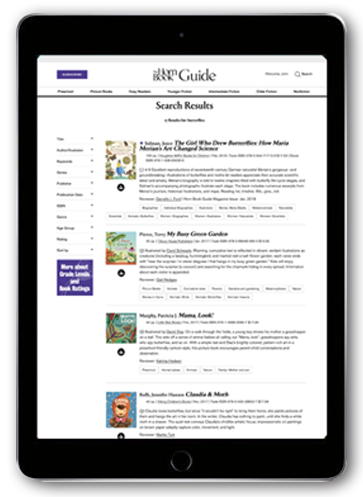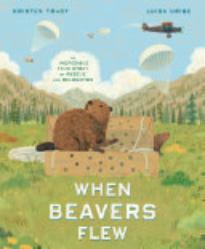Wildlife reintroduction
39 Reviews
(2)
K-3
Illustrated by
Tiffany Bozic.
Acting as narrator, a young hummingbird describes his first year, beginning when "my older sister and I hatch, two days apart, from eggs as small as navy beans." They feel a breeze "many times a day," signaling that food is coming. And then one day it doesn't. The two wait, cold and hungry, until the next morning when the breeze returns. Here listeners must infer what has happened; a human hand lifts their tiny nest and uses a syringe to feed the babies. They are orphans, now living in a hummingbird rescue center and gradually learning the skills they will need to survive in the larger world. Realistic and delicate, Bozic's depictions of the main points in the narrative (learning how to hover, sip nectar, and catch insects) are rendered in acrylic paint on wood with the birds placed in natural settings and poses, resembling the best of scientific illustrations. Readers follow the two as they make their way in the world, migrate south for the winter, and then return to find mates. An author's note explains that this touching success story is based on an observed hummingbird rescue. Montgomery outlines ways to save such abandoned birds (clearly emphasizing that readers shouldn't try this at home) and the many resources available to help these tiny animals of the Americas. Also appended are facts about hummingbirds, including their size and habitats.
Reviewer: Betty Carter
| Horn Book Magazine Issue:
March, 2024
 Tracy, Kristen
Uribe, Luisa, Illustrator
Tracy, Kristen
Uribe, Luisa, Illustrator
When Beavers Flew: An Incredible True Story of Rescue and Relocation
(2)
K-3
The environmental contributions of beaver dams are well documented. But too many beavers can cause problems, particularly for humans attempting to alter the landscape for their own purposes. Such was the situation in McCall, Idaho, in 1948 when Fish and Game warden Elmo Heter sought a nonlethal way to remove the excess beaver population. Transporting the animals across mountainous terrain to the nearby preserve of Chamberlain Basin, where they had been hunted to near extinction a hundred years previously, proves impossible. But when Heter discovers a stash of parachutes left over from World War II, he wonders if he can devise a beaver airlift. He cleverly constructs boxes that can hold the creatures, be dropped from planes, and open automatically when they land. This translocation was a near-total success; only one out of seventy-six did not make it, and the rest thrived in their new location and restored the balance of the area's ecosystem. Using an earth-toned palette, Uribe's computer-generated, retro-style illustrations superbly reflect both the physical setting and the historical times. Faux artifacts such as notebook pages, hand-tied flies, and even a cliffside depiction of Native artwork decorate some pages. An author's note goes deeper into the events (including problems with translocation) and provides information about humans and animals coexisting peacefully. A bibliography of selected sources completes the book.
Reviewer: Betty Carter
| Horn Book Magazine Issue:
September, 2024
(1)
K-3
Illustrated by
Richard Jones .
When Yoshi, a real-life loggerhead turtle, hatches, she immediately crawls to the Indian Ocean and begins swimming out to sea. After five nomadic years, she becomes entangled in a fishing net (a sequence of events Jones depicts as a timeline of circles, each spotlighting her increasing distress). Unable to breathe, she begins an arduous journey to the surface, dramatically illustrated in a full-bleed, double-page watercolor spread showing Yoshi alone in the sea hauling a mass of fishing net behind her. A fisherman rescues her, eventually taking her to Cape Town's Two Oceans Aquarium, where she lives for twenty years. When Yoshi reaches sexual maturity, the aquarists initiate a program of reintroducing her into the wild; they finally do so, equipping her with a satellite tracker. To the scientists' surprise, she swims up the western coast of Africa, turns around, heads south, and returns to her heretofore unknown native beach in Australia, where she mates and deposits her eggs on the very shore where she originally hatched--a 22,998-mile journey. There's much to discuss about the interplay of instinct, perseverance, and luck in this fine book. An author's note describes Cox's inspiration--"I am intrigued by Yoshi's story because I too am a long-distance swimmer. I was the first person to swim around the rough waters surrounding the Cape of Good Hope, Africa" --and separates fact from supposition; a suggested website documents Yoshi's release.
Reviewer: Betty Carter
| Horn Book Magazine Issue:
March, 2023
(2)
K-3
Illustrated by
Renato Alarcão.
Seu Joao lives on an island off the coast of Brazil. When an oil-soaked Magellanic penguin washes ashore, Seu Joao takes him home, cleans him with dish soap, and names him Dindim (a grandson's attempt to pronounce the Portuguese word for penguin). As Dindim rehabilitates, the pair forms an attachment, though Seu Joao, respectful of the needs of wild animals, repeatedly tries to send Dindim back to the sea. Dindim does not leave--until one day, months later, he does. Earle's account of this true story is skillfully restrained, describing only the two characters' actions, and leaving readers to infer what human and animal feel for each other. "Seu Joao sat and drank his coffee. His lap was empty. But he remembered Dindim's silky feathers and the beat of his heart." Four months later, when Dindim amazingly returns, "the penguin waddled as fast as his little legs could carry him, right into Seu Joao's arms." Alarcao's pastel-colored illustrations capture the appeal of the people, animals, and beaches of Praia Proveta. In addition to a brief glossary, appended notes provide additional information about Seu Joao and Dindim, facts about penguins and threats to their survival, and steps that readers can take to help protect threatened species.
Reviewer: Danielle J. Ford
| Horn Book Magazine Issue:
January, 2023
(2)
K-3
As he often does, Say retells a moving story from his childhood in post WWII Japan. An eight-year-old boy rescues an injured baby sparrow from some bullies intent on tormenting it, trading them everything he can think of, including his father's American baseball. When he arrives home, his mother is sympathetic but not especially hopeful, while his father shouts, "Nothing can save that creature!" Resolute, the boy names the bird Kozo and figures out how to nurse it back to health. One day Kozo escapes--but the two have grown close, and the bird flies back to the boy. When his well-meaning teacher persuades him to bring the bird to show his class, promising to keep the other children away, things don't go as planned, and he leaves school with the bird, only to find the same bullies waiting outside for him. He runs and runs but realizes the only thing to do is to open the birdcage; the final spread is wordless, showing a flock of sparrows in the sky and Kozo flying away, presumably joining them. The ending is sudden and heartbreaking, but the boy has again saved his beloved bird; an author's note closes the affecting book. Say's pen, ink, and watercolor illustrations depict with equal clarity the rural Japanese setting and the young protagonist's quiet determination and devotion.
Reviewer: Jennifer M. Brabander
| Horn Book Magazine Issue:
November, 2023
(2)
4-6
Illustrated by
Charles Santoso.
Applegate and Santoso (Willodeen, rev. 9/21) pair for another creature story, this one a verse novel about an otter named Odder who lives off the coast of California near Monterey Bay. The tale is divided into three sections, beginning with "The Queen of Play," a reference to Odder's daredevil nature. But the opening poems are about sharks, foreshadowing what is about to happen. On this day Odder can't resist going a little too far, despite her more cautious friend Kairi's warnings, and is attacked by a great white shark; she manages to make her way to the Monterey Bay Aquarium. The second section flashes back to three years earlier, when as a baby Odder became separated from her mother and was rescued and painstakingly taught survival skills by the aquarium's aquarists. The final section returns to the present, as Odder, too injured to be returned to the wild, becomes a surrogate parent to another otter pup that has lost its mother. Applegate grounds the story in scientific fact, slipping in interesting details in a lyrical way, as when she talks about keystone species, "nature's glue, / holding habitats together." "Without otters, / sea urchins, purple as a bruise, / gobble kelp forests / until the ocean floor / becomes a barren wasteland." Santoso's tender black-and-white drawings, together with the large type, will make this novel very accessible and appealing to young animal lovers. Back matter includes a glossary; an author's note about Monterey Bay Aquarium and the real-life stories on which Odder's is based; and a selected bibliography.
Reviewer: Susan Dove Lempke
| Horn Book Magazine Issue:
November, 2022
(2)
K-3
Illustrated by
Jenni Desmond.
Today in the wild expanses of Yellowstone National Park, wolves roam freely. This was not the case for most of the twentieth century, as wolves there were hunted out of existence by 1926. In 1995, through the efforts of scientists (opposed by some ranchers and hunters), fourteen wolves were reintroduced, and they survived to produce today's flourishing population. Barr splits her informative tale into two parts: first, the conservation story of how the wolves were brought from Canada, including details about wolf life cycles throughout the seasons. As the wolf population increased, the packs gradually spread out through the park and established hunting grounds in their territories. Desmond's graceful watercolors of the animals in summer and winter landscapes give a sense of the breadth and diversity of nature in the protected spaces of the American West. In the second half, Barr illustrates the effects of the wolves return on the entire ecosystem (a graphic in the endpapers compactly diagrams this concept of trophic cascade). Barr includes not just the main food chains but the full range of ecological impacts: insects, grasses, trees, even the water levels and paths of rivers change in response. The final pages include profiles of the fourteen original wolves and examples of other human interventions to reintroduce species affected by human activity.
Reviewer: Danielle J. Ford
| Horn Book Magazine Issue:
March, 2022
(2)
4-6
Illustrated by
Jeet Zdung.
Nguyen's graphic novel "based on a true adventure" tells the story of a girl named Chang, who is an aspiring wildlife conservationist, and her efforts to protect Vietnam's native species and natural environments. Accompanying Chang is Sorya, a sun bear rescued in Laos, who must learn survival skills before she can be safely returned to the forest. Zdung's expressive, expansive comics-style panels depict Sorya's many playful antics moment by moment, as well as the fast-paced tension in more dangerous interactions in the wild. Clever picture-within-picture illustrations from Chang's field-notebook sketches incorporate information on topics ranging from bear species to the many ways humans exploit wild animals for profit. The warmth of the characters' relationship is conveyed with a minimum of anthropomorphism. The conversational narrative is occasionally paused by gorgeous interspersed partial-to-full spreads of Vietnamese rainforest landscapes filled with the heat, moisture, and density of tropical plant and animal life. Sorya eventually returns to the wild, while Chang continues her lifelong efforts to protect the forests and their inhabitants from human exploitation done through development, farming, dams, and the illegal animal trade. Brief author and illustrator notes are appended.
Reviewer: Danielle J. Ford
| Horn Book Magazine Issue:
January, 2022
(3)
4-6
Scientists in the Field series.
Photographs by
Tianne Strombeck.
Veteran science writer Montgomery provides insight into the work of saving the California condor. This book focuses on Dr. Estelle Sandhaus, director of conservation science at the Santa Barbara Zoo, and her team of wildlife biologists, who have successfully reintroduced the species into the wild. With characteristic enthusiasm for her subject, Montgomery discusses how the zoo cares for condors in captivity, meticulously tracks birds in the wild, and learns from successes and mistakes. Both the passionate text and well-captioned color photos encourage respect for these impressive birds. "What You Can Do" suggestions are appended, as are a timeline, bibliography, related websites, and index.
Reviewer: Kitty Flynn
(3)
4-6
True Tales of Rescue series.
Photographs by
Shelly Ross.
The rescue stories of four orphaned raccoon kits and an injured anteater pup are used to spotlight the work of two animal sanctuaries in these series entries. Accessible text, engaging photographs, and frequent informational sidebars allow readers to shadow the volunteer caregivers as they work toward the ultimate goal: releasing the animals back into the wild. One of the young creatures "narrates" part of each book. Bib., glos., ind. Review covers these True Tales of Rescue titles: Anteater Adventure and Racoon Rescue.
Reviewer: Gail Hedges
(3)
4-6
True Tales of Rescue series.
Photographs by
Ella Baron.
The rescue stories of four orphaned raccoon kits and an injured anteater pup are used to spotlight the work of two animal sanctuaries in these series entries. Accessible text, engaging photographs, and frequent informational sidebars allow readers to shadow the volunteer caregivers as they work toward the ultimate goal: releasing the animals back into the wild. One of the young creatures "narrates" part of each book. Bib., glos., ind. Review covers these True Tales of Rescue titles: Anteater Adventure and Racoon Rescue.
Reviewer: Gail Hedges
(3)
4-6
In an engaging and balanced narrative, Thimmesh describes Chinese conservation researchers' groundbreaking efforts to reintroduce pandas to the wild and the challenges this vulnerable species faces given their small numbers and vanishing habitats. Numerous photographs show adorable pandas and their human caregivers--innovatively dressed in panda suits to shield developing pandas from human contact. "What Can You Do?" section included. Bib., glos., ind.
Reviewer: Danielle J. Ford
(3)
K-3
Wildlife photographer Eszterhas recounts her experience in Kenya fostering an orphaned serval kitten (spotted wildcat) named Moto. Striking photographs and useful captions enhance the chronicle of Eszterhas's journey from her first days learning to care for Moto to his bittersweet return to the wild. Brief sections and a table of contents make up for the lack of an index. Important facts about servals appended.
Reviewer: Russell Perry
(4)
K-3
Illustrated by
Shennen Bersani.
A monk seal got a fishhook caught in her mouth and almost starved. Rehabilitated by a team of scientists, "Honey Girl" was released back into Hawaiian waters. Readers will cheer Honey Girl's recovery and birth of healthy pups into the endangered population. Unfortunately, no photos are included, but the realistic illustrations are somewhat appealing. Four pages of additional information and activities are appended. Bib.
Reviewer: Janet Dawson
(4)
4-6
With Brenda Z. Guiberson. Naturalist Hutto finds abandoned wild turkey eggs and raises the flock, ever-mindful of his responsibility to keep the turkeys both safe and wild. For two years Joe is "mother," learning of turkeys' intelligence and curiosity, mourning when some die, and adjusting when they become independent. A third-person narrative feels at odds with the personal, intimate true story. Hutto's sketches and photos are included. Bib., glos., ind.
Reviewer: Gail Hedges
(3)
K-3
Anna Merz, a conservationist working to save wildlife in Kenya, raised abandoned baby rhino Samia at her home. Samia behaved rather pet-like, but Anna also taught her skills for living in the wild when fully grown. Earth-toned pencil and Photoshop illustrations accentuate Samia's affection for Anna and effectively depict the setting of this warm story. An author's note explains more about the unlikely pair. Bib.
(3)
4-6
Science Comics series.
With lighthearted graphic-novel presentations, this series continues to educate readers about science topics. As a little brown bat narrator recovers in a wildlife rehabilitation center, he meets--and introduces readers to--bats from around the globe. The basic comic-book layout and style make the book easy to read, while facts about types of bats, their habitats, diets, etc., are engagingly relayed. Reading list. Glos.
Reviewer: Antonio Trujillo
(4)
4-6
Illustrated by
Susan Meyer.
"Spirit Child" for rebel fighters in the Congo, scarred Imara knows not to show weakness. When the rebels capture a baby gorilla for the exotic pet trade, it falls to Imara and fellow child Bobo--captured while searching for his missing park-ranger father--to keep it alive. An overwrought ending slightly mars this gripping look at the environmental and human costs of war.
Reviewer: Anita L. Burkam
(3)
K-3
Illustrated by
Bistra Masseva.
Based on a true story of elephant friendship, two wild elephants are taken into captivity and endure hardships at circuses and zoos. Precious and Baba are eventually reunited at an elephant sanctuary. The moving story, told in spare, poetic text and emotive, colorful illustrations, will surely tug animal lovers' heartstrings. Includes a note on elephant conservation and circus mistreatment. Websites. Bib.
Reviewer: Kristine Caldwell
(4)
1-3
Animal Rescue Center series.
Illustrated by
Artful Doodlers.
Each UK-import chapter book opens with a mock website for Animal Magic Rescue Center, owned by Ella Harrison's family. In Foal, the shelter's first ponies join the cats, dogs, rabbits, and goats. Fox describes the tricky balance between healing an injured animal and preserving its ability to return to the wild. A bit saccharine, but with obvious appeal for animal-loving young readers. Review covers these Animal Rescue Center titles: The Homeless Foal and The Injured Fox Kit.
Reviewer: Gail Hedges
39 reviews
We are currently offering this content for free. Sign up now to activate your personal profile, where you can save articles for future viewing.























